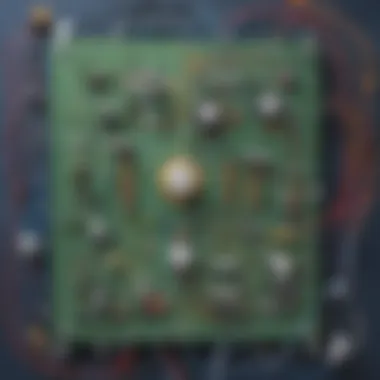Exploring Cutting-Edge Electric Project Innovations for Young Science Enthusiasts


Science Fun Facts
As young Science enthusiasts embark on their journey into the realm of electric project innovations, here are some intriguing Science fun facts to pique their curiosity. Did you know that electricity travels at the speed of light, approximately 186,282 miles per second? This incredible speed allows electricity to power up our homes and gadgets in an instant. Furthermore, electrical signals in our brains move at about 270 miles per hour, enabling us to think, learn, and experience the world around us.
Discover the Wonders of Science
Delve deeper into the captivating world of Science through Lab Littles, an interactive infotainment portal designed to engage young minds aged 6-12. Explore various scientific concepts from the fundamentals of basic circuits to more advanced experiments. With educational videos, animations, and interactive learning tools, LabLittles offers a dynamic platform to discover the practical applications of Science in everyday life.
Science Quiz Time
Enhance your knowledge through interactive quizzes, multiple choice questions, brain teasers, and puzzles that make learning Science a fun and engaging experience. Test your understanding of electric project innovations while enjoying the gamified approach to education. Prepare to challenge yourself with stimulating questions that foster critical thinking and problem-solving skills tailored for young Science enthusiasts.
Science Experiment Showcase
Embark on a hands-on journey through a showcase of fun and engaging experiments rooted in electric project innovations. Follow step-by-step instructions carefully curated for young learners, complete with a detailed materials list and essential safety tips. By prioritizing precaution and guidance, aspiring scientists can safely explore the wonders of Science through practical applications and experimentation.
Basic Safety Precautions: In addition to supervision, Basic Safety Precautions form the basis of a secure and risk-free electric project environment. Educating young minds about fundamental safety measures such as avoiding water contact while working with electricity, wearing insulated gloves, and double-checking connections before powering up circuits is paramount. By instilling these safety protocols into young learners, Basic Safety Precautions ensure a safe and enjoyable learning experience free from accidents or mishaps. Understanding the importance of safety measures not only cultivates responsible behavior but also fosters a culture of attentiveness and awareness when conducting electric experiments. With a focus on preemptive safety practices, this section equips young innovators with the necessary tools to explore electric projects with confidence and security.
Basic Electric Project Ideas
Building a Simple Circuit
Gathering Materials
Gathering materials is a pivotal aspect of constructing a Simple Circuit. The selection of materials plays a crucial role in ensuring the circuit's functionality and safety. High-quality components such as wires, batteries, and bulbs are essential for the smooth operation of the circuit. By emphasizing the importance of gathering materials, young learners can grasp the significance of using the right tools to execute their electrical projects effectively.
Key Characteristics:


- Durability: The materials chosen for the circuit must be durable to withstand the electrical currents passing through them.
- Compatibility: Ensuring that the materials are compatible with each other is vital for seamless circuit connectivity.
Unique Feature: The unique feature of gathering materials lies in its ability to enhance the learning experience by allowing children to interact with tangible components, facilitating a hands-on approach to understanding electrical concepts.
Step-by-Step Assembly Instructions
Step-by-Step Assembly Instructions provide young enthusiasts with a structured guide to build their Simple Circuit accurately. These instructions outline the order of connecting components, wiring techniques, and safety precautions to follow during the assembly process. By following these instructions diligently, children can not only construct the circuit successfully but also develop essential skills in following procedures and attention to detail.
Key Characteristics:
- Clarity: The instructions must be clear and concise, ensuring that each step is easily understandable for young learners.
- Safety Emphasis: Incorporating safety measures into the assembly instructions reinforces the importance of maintaining a secure environment during project execution.
Unique Feature: The unique feature of Step-by-Step Assembly Instructions lies in their ability to cultivate a structured approach to problem-solving and sequential thinking among young science enthusiasts, laying a solid foundation for future electrical projects.
Creating a Light-Up LED Card
Designing the Circuit Layout
The process of designing the Circuit Layout for a Light-Up LED Card is a critical component of this electric project. The layout design dictates how the LED, battery, and connecting wires align to illuminate the card effectively. By focusing on designing the circuit layout, children can enhance their spatial reasoning skills and creative thinking, fostering a holistic understanding of circuitry and design principles.
Key Characteristics:
- Efficiency: The layout design should be optimized for efficient energy transmission and minimal component usage.
- Aesthetics: Incorporating aesthetic elements into the circuit layout enhances the visual appeal of the LED card, promoting creativity and individuality.
Unique Feature: The design of the circuit layout offers young innovators the opportunity to merge functionality with creativity, allowing them to personalize their projects while honing their technical skills.
Adding Personalized Touches


Adding personalized touches to the Light-Up LED Card injects a sense of individuality and creativity into the project. Through customization such as decorating the card with personal messages or illustrations, children can imbue their creations with unique character and expression. This aspect not only fosters artistic development but also instills a sense of pride and ownership in the project, encouraging further exploration in the realm of electric projects.
Key Characteristics:
- Expression: Personalized touches enable children to express their creativity and personality through their projects.
- Engagement: Involving children in the customization process promotes active participation and engagement in the project.
Unique Feature: The addition of personalized touches infuses a sense of identity into the Light-Up LED Card, transforming it from a standard project into a personalized masterpiece, showcasing the young innovator's distinct style and flair.
Intermediate Electric Projects for Young Innovators
The section on Intermediate Electric Projects for Young Innovators serves as a crucial segment in this article, providing young enthusiasts with a step towards more complex and engaging experiments. Here, participants will delve deeper into the realm of electricity, gaining a richer understanding of its applications. By exploring series and parallel circuits and constructing a simple electromagnet, learners will develop valuable skills and knowledge essential for their scientific growth. This section emphasizes hands-on learning and practical experimentation, fostering a sense of curiosity and innovation among budding scientists.
Exploring Series and Parallel Circuits
Understanding Circuit Configurations
Understanding Circuit Configurations plays a pivotal role in the realm of electricity, shaping how electrical components interact within a circuit. By grasping the nuances of series and parallel connections, young innovators can comprehend how different configurations impact current flow and voltage distribution. This knowledge is fundamental for designing efficient circuits and troubleshooting potential issues. The unique feature of Understanding Circuit Configurations lies in its ability to provide a structured approach to circuit design, offering a clear path towards optimizing electrical systems. While series circuits are renowned for their simple setup and predictable outcomes, parallel circuits offer increased reliability and versatility in creating complex circuits.
Hands-On Experimentation
Hands-On Experimentation allows young scientists to apply theoretical knowledge to practical scenarios, solidifying their understanding of circuit behavior. Through hands-on activities, participants can witness firsthand how series and parallel circuits differ in performance and functionality. This hands-on approach nurtures critical thinking and problem-solving skills, enabling participants to experiment with various circuit configurations and observe the resulting effects. The key characteristic of Hands-On Experimentation is its ability to bridge the gap between theory and application, empowering young innovators to translate concepts into tangible outcomes. By engaging in hands-on experimentation, participants can explore the diverse possibilities of circuit design and gain insights into real-world applications.
Building a Simple Electromagnet
Constructing a Simple Electromagnet delves into the fascinating world of magnetism, demonstrating how electricity can generate magnetic fields. Participants will discover the materials required to build an electromagnet and follow step-by-step instructions to assemble this captivating device. Through this hands-on activity, young innovators will learn about the relationship between electricity and magnetism, laying the foundation for future explorations in electromagnetism. The process of constructing an electromagnet not only enhances participants' practical skills but also nurtures their creativity and problem-solving abilities.
Materials Required


The materials required for constructing an electromagnet include a battery, insulated copper wire, iron nail, and a switch. These components are essential for creating a simple yet effective electromagnet that can attract magnetic objects when electricity flows through the wire. Each material serves a critical role in the construction process, emphasizing the importance of using the right components for optimal performance. By understanding the significance of each material, young innovators can appreciate the interconnected nature of electromagnetism and electricity.
Constructing the Electromagnet
Constructing the electromagnet involves winding the insulated copper wire around the iron nail, creating multiple coils to intensify the magnetic field. By connecting the wire to the battery through a switch, participants can control the flow of electricity and activate the electromagnet at will. This hands-on construction process not only reinforces the principles of electromagnetism but also instills a sense of accomplishment as young innovators witness the nail attracting magnetic objects. The unique feature of constructing an electromagnet lies in its ability to demonstrate the direct relationship between electricity and magnetism, sparking curiosity and promoting further exploration into this captivating scientific phenomenon.
Advanced Electric Project Innovations
In the realm of electric project innovations tailored for young Science enthusiasts aged 6-12, the segment of Advanced Electric Project Innovations stands as a pinnacle of exploration. This section serves as a gateway into the more intricate and exciting realms of electrical experimentation, offering a hands-on approach to understanding complex concepts. Young innovators are encouraged to delve deeper into the mechanisms behind electronic creations, honing their problem-solving skills and fostering a genuine passion for scientific discovery. Advanced Electric Project Innovations not only expand young minds' horizons but also empower them to think critically and creatively, laying the foundation for future advancements in the field of science.
Designing a Battery-Powered Car
Conceptualizing the Design
When it comes to Conceptualizing the Design of a battery-powered car, young scientists embark on an imaginative journey of merging form and function. This stage is crucial as it sets the blueprint for the entire project, requiring careful consideration of factors such as car size, battery placement, and design aesthetics. By conceptualizing the design, young minds sharpen their visualization skills and learn the importance of meticulous planning in the execution of a complex project. The ability to conceptualize the design not only enhances problem-solving abilities but also fosters an appreciation for the synergy between creativity and practicality in engineering endeavors. Young scientists explore various design possibilities, fueling their curiosity and innovation while building a solid foundation for future engineering pursuits.
Assembling the Components
Assembling the components of a battery-powered car entails translating the conceptual design into a tangible working model. This stage involves selecting the appropriate materials, assembling the chassis, integrating the electrical components, and fine-tuning the mechanisms for optimal performance. Young innovators have the opportunity to develop fine motor skills, enhance their understanding of mechanical systems, and grasp the importance of precision in manufacturing processes. By assembling the components, budding engineers delve into the intricacies of electrical connections, troubleshoot potential issues, and witness firsthand how individual components come together to form a cohesive and functional whole. This hands-on experience not only cultivates a deeper comprehension of engineering principles but also instills a sense of accomplishment and pride in bringing their ideas to life through practical application.
Creating a Solar-Powered Device
Harnessing Solar Energy
Harnessing Solar Energy opens a world of eco-friendly possibilities for young scientists venturing into the realm of renewable energy sources. By harnessing the power of sunlight, budding innovators learn about the importance of sustainable energy practices and the transformative potential of solar technology. The process of harnessing solar energy involves understanding photovoltaic principles, selecting efficient solar panels, and optimizing energy capture for improved device functionality. Young minds discover the environmental benefits of solar power and engage in critical thinking about harnessing natural resources responsibly. Exploring solar energy not only broadens children's scientific horizons but also instills a sense of environmental stewardship and encourages them to seek innovative solutions to address pressing global challenges.
Building the Prototype
Building the Prototype marks the transition from theoretical concepts to hands-on experimentation, allowing young scientists to apply their knowledge in a practical setting. The prototype serves as a testing ground for integrating solar components, assessing energy output, and refining the device's functionality based on performance evaluations. Through the building process, young innovators refine their engineering skills, experiment with design modifications, and gain insights into iterative development cycles. Building the prototype offers a glimpse into the iterative nature of innovation, encouraging perseverance, adaptability, and continuous improvement. By creating a functional prototype, young scientists not only showcase their technical aptitude but also cultivate a mindset of innovation and a drive to explore the frontiers of solar technology for a more sustainable future.
Conclusion
Encouraging Curiosity and Innovation
Inspiring Young Scientists







